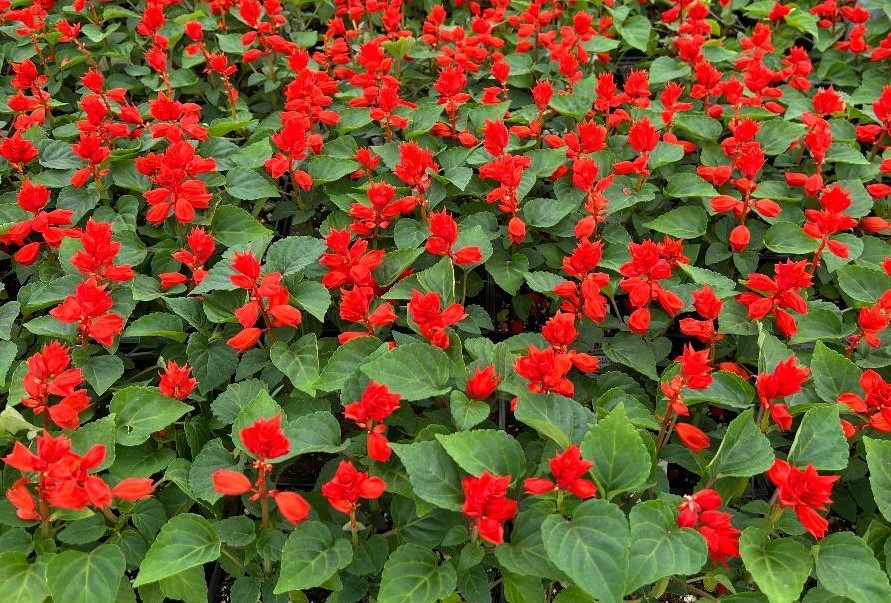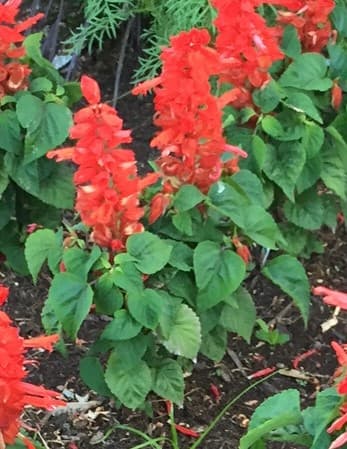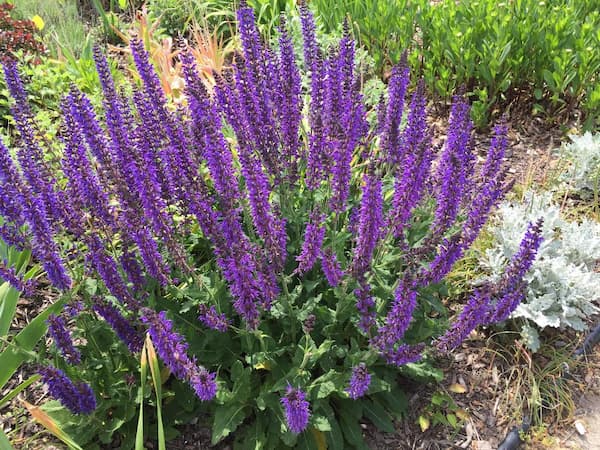How to Grow and Care for Salvia Flowers

About Growing Salvia Plants in Your Home Flower Garden
If you are looking for variety, growing salvia plants is for you. flower. There are over 900 species of this plant that originated in warm and temperate climates. There are annual and perennial varieties aplenty. Spiky Salvia flowers are borne on bushy plants. You most likely know, and readily recognize, the bright red and scarlet Salvia. But, the flowers are also found in most other colors, including blue.
Did you know? Sage is salvia. It is classified as an herb and a flower. They are members of the mint family.
Salvia makes nice bouquets fresh or dried for winter use.
Salvia Flowers Plant Specifications
Flower Colors: Shades of blue, orange, purple, red, scarlet, and yellow.
Flowers Bloom: Late spring to early Summer.
Plant height: Plant size generally ranges from 10 to 60 inches. But, most varieties below 36″.
Ideal Soil pH: 6.0 – 7.5.
Plant Hardiness Zones: 3 – 8
Light Needs: Bright, full sunlight.
Toxic Plant?: No.
Deer Resistant? Yes. The plant’s strong scent is a deterrent to deer, rabbits, and other foraging animals.
Number of Species: 900 to 1,000 species.
Plant Type: Annuals and Perennials.
Botanical Name: Salvia officinalis
Are Salvia Plants Edible?
YES!! and NO!!
Some varieties are perfectly safe to consume. Some of them are the sage herb that you find in your herb rack. But, others are toxic and harmful to you.
We recommend you do not eat any varieties of Salvia plants unless you can positively identify them as a variety that is safe to eat.
Medicinal Uses for Salvia Plants
With so many species of Salvia, there are certain to be a variety of medicinal uses for these plants. They have antiseptic and antibiotic properties. Here are some of them:
It is currently being studied as a potential treatment for Alzheimer’s disease and other forms of dementia.
Use it to treat digestive problems.
Some people use it to tone the nervous system.
Important Note: Because some varieties are toxic, we do not recommend using it in home remedies unless you are properly trained in the safe medicinal preparation of this plant.

Light Requriements
For healthy plants and brilliant blooms, grow Salvia plants in full sunlight. Select a planting location where they will receive a minimum of six hours of bright, direct sunlight each day.
You can also grow them in light shade However, with too little light, the plants get leggy and produce fewer blooms.
Salvia Plant Propagation
Salvia plants are often grown from seeds. They can be directly seeded into your flower garden or seeded indoors for transplanting later.
Some varieties require light to germinate, and the seed should be spread on the top of the soil. Water lightly as the fine seeds can wash away or penetrate too deeply into the soil.
For indoor starts, sow seed 8 – 10 weeks before the last frost in your area.
Note: For indoor starts, we recommend using a heated germination mat, to increase the speed of germination. And, it, results in a higher germination rate.
Transplant Salvia into your garden after the last frost date for your area.
Final Plant Spacing: Space them 10 – 20 inches apart, depending upon species. They look good grown in groups. They tolerate a little, but not too much crowding.
For perennial varieties, salvia plants can also be propagated by division, which is best done in the spring.
Days to Germination: 15 – 21 days.

How to Grow Salvia Flower Plants
Planting location:
Salvia plants grow best in full sun. Many Salvia varieties are heavy re-seeders. Place them in an area where you want them to re-seed the area each year. Also, select a section of the flower bed where you can see these pretty flowers from your deck or a window of your home. Once your Salvia plants are established, they should grow well with few problems.
Soil and fertilizer needs:
They grow well in average or better soil, but the soil should drain well. Mix in a generous amount of compost at the planting site. After planting them, apply a general-purpose fertilizer when planting them. This will give the young plants a quick start. Then, re-apply fertilizer once a month after that. Just before the blooming period, use a high in phosphorous fertilizer to promote a profusion of brightly colored flowers.
Water needs:
Salvia plants are heat and drought tolerant. Typical of plants with these characteristics. they prefer slightly dry soil. So, keep the soil moist to slightly dry. Water them during dry periods, once or twice per week. During other times of the growing season, they likely will not require any additional water.
Keep the plants well weeded. Then after they grow a few inches tall, apply a two to three-inch layer of mulch around the plants for a tidy appearance. The mulch also helps to retain soil moisture.
How to Grow Salvia Plants in Flowerpots and Containers
Bright and attractive Salvia flowers will look great growing in flowerpots or containers on your balcony, or deck.
Like any container-grown plant, they need a little more care and attention. In addition to normal plant care, here’s how to grow Salvia flowers in containers:
- As previously mentioned, Salvia plants look good growing together in groups. And they tolerate a little overcrowding. So, grow them in containers closer than recommended.
- Select a sunny to partly sunny location on your deck.
- It is important to have a drain hole in the container to allow excess water to drain from the pot.
- Keep an eye on the moisture level. Check the plants every few days, especially in extended periods of hot, dry weather.
- Keep the soil slightly dry to moist, but not wet. Let the top of the soil begin to dry between watering.
- When watering the plants, thoroughly wet the soil. Excess water will drain through the hole in the bottom of the flowerpot.
- Nutrients in a flowerpot are limited. So, use fertilizer spikes to feed the plants. Or, apply a light solution of liquid fertilizer once a month.
How to Prune Salvia Plants
Salvia plants benefit from aggressive pruning. If the plants look leggy and there are no buds on the plant, cut them back. In every case, a trim soon rewards you with a bushier and more attractive looking plant. Also, keep an eye out for dead, damaged, or diseased leaves and stems. Then, cut them off when you see them.
In mid-spring before the first buds appear, give the plants their first trim. Cut them back by one third. Then after the first set of blooms has died off, cut them back again lightly in mid-summer. The plant will produce more flowers.
Deadhead the flowers to encourage more buds to form. However, as Fall nears, allow a few dead flowers to remain on the bush to produce seeds and reseed the area for next year. And, you can harvest some of the seeds to plant in another location next year. Importantly, don’t forget to give some of the seeds to your gardening friends.
More on deadhead spent flower blooms.
Insects and Plant Disease
Insect and disease problems are not too common. If insect infestations or disease problems occur, treat early with fungicide.
Also see: Plant Problems – Identify the causes and find the cures.
Overwintering Salvia Plants
If you are growing annual varieties of Salvia, simply pull up the plants after the first killing frost in the Fall. Then, toss the plants into your composter or compost pile.
Overwintering Salvia Plants Outdoors
Do not cut the plant back in the Fall. Apply a thick layer of mulch over the root area to protect the crowns. Then, in the early spring, rake off the excess mulch. Prune back any winter-damaged growth.
For Overwintering Salvia Plants in Containers
If left outdoors in cold northern climates, the crown can freeze and die. This will damage or kill them. So, plan on sheltering the containers from the most brutal winters. Bring the container into a cool garage or shed. Bring the containers back onto your patio or deck in mid-spring. Cut back any growth that has died during the winter months.
Related Articles
Also, people who read this article will like:
How to Grow Salvia Plants – by Garden Hobbies
Please support our site. Shop for:
- rmmatthews100@hotmail.com
- 585-721-6528
- Rochester, NY
©1999-2024 GardenersNet.Com, All Rights Reserved

